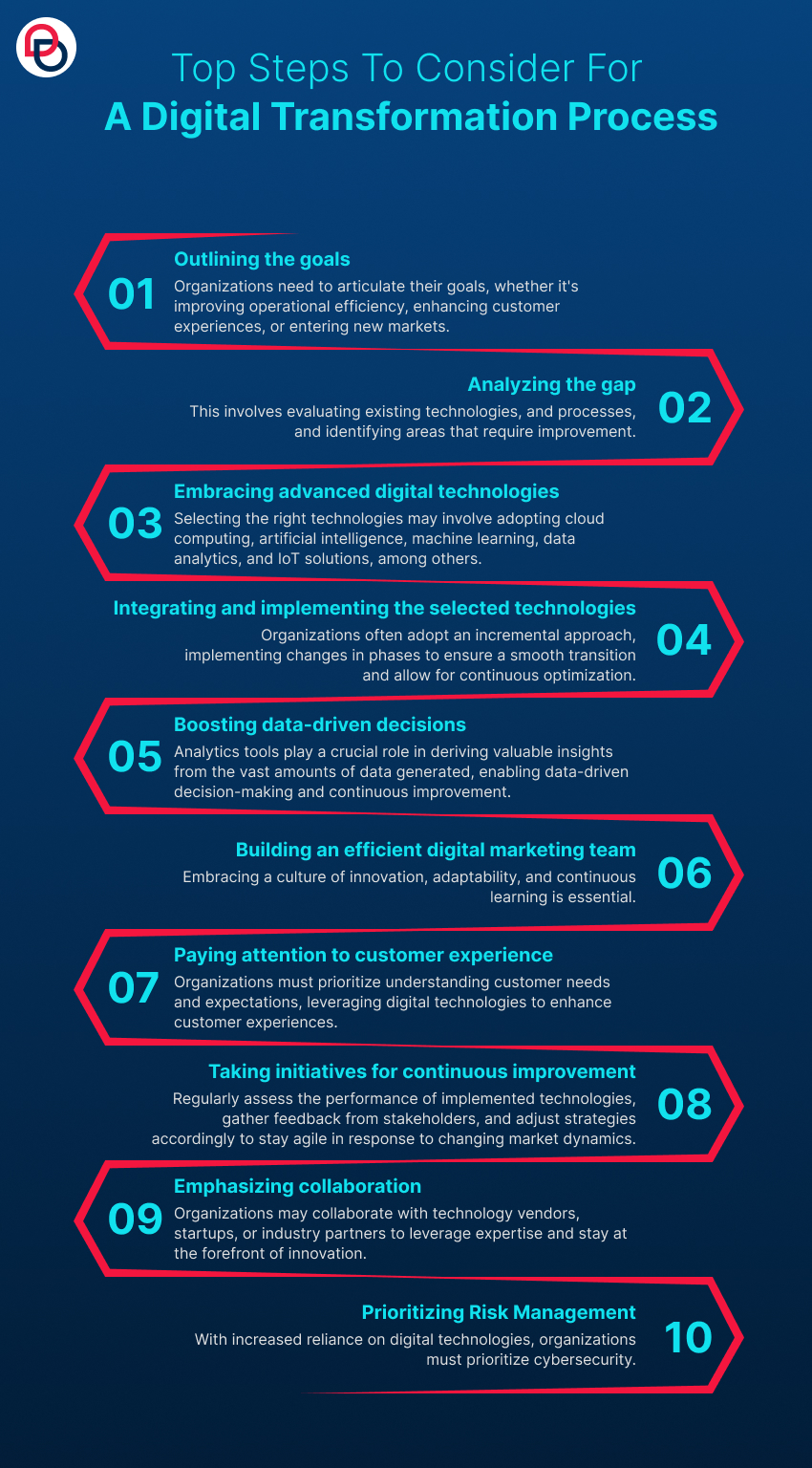From Evolution to Revolution: Excellence of Digital Transformation
Summary: Digital transformation highlights the integration of digital technology into all aspects of business operations. It helps enterprises modernize legacy processes, and boost efficient workflows. Read the blog to find out how digital transformation strategies can drive business growth.
Are you still not getting the expected return on investment after revamping your business strategy? Have you transformed your business digitally to get maximum recognition from your target audience? If not, it’s time to harness the full power of advanced technologies to bring digital transformation to your business.
Digital transformation has conquered a large number of industries globally; changing the way businesses operate internally as well as overseas. The UAE is leading the digital transformation curve in the Arab world. The UAE has embraced digital transformation graciously. Digital technology expenditures in the UAE such as IT, AI, IoT, robotics, blockchain, and telecoms are predicted to touch $20 billion over the next three years. As evident from the figure below, the UAE possesses the highest degree of digitization as compared to Saudi Arabia and Egypt.

Source: Digitization in the UAE / McKinsey & Company
Like any other business process that drives significant changes, digital transformation can bring immense benefits to your enterprise. However, inaccurate implementation of a digital transformation strategy can create hurdles for your business growth.
Today, we will discuss the top aspects of digital transformation: what it is and how it can take your business to the next level.
Understanding Digital Transformation
Isn’t it exciting that you can buy remarkable designer apparel online without visiting the store personally? How do you feel when getting a cup of cappuccino and pepperoni pizza delivered to your doorstep after a hectic work schedule? Do you want to replace your existing air conditioning system? Getting an appointment with the technician is at your fingertips! These are all digital age testaments and marvels of digital transformation trends. Today, businesses can do a lot more to establish their brand identity by leveraging emerging digital technologies.
So, digital transformation is the use of new digital platforms, tools, and business models to gain a competitive advantage in this rapidly changing business landscape. Digital transformation revamps the existing business processes, workplace culture, or customer experience to drive business growth. The global digital transformation market size is predicted to exceed USD 6.78 trillion by the end of 2029. Gulf Cooperation Council (GCC) countries like the UAE and Saudi Arabia are investing extensively in AI and advanced technologies to embrace digital transformation. The UAE has already developed a digital government strategy to boost the contribution of the digital economy to the nation’s GDP from 9.7% to 19.4% over the next 10 years.

Source: Digital Transformation in the UAE / Khaleej Times
Due to the ever-changing consumer habits and expectations, all businesses across industries must adopt digital changes. Digital transformation touches all departments of an enterprise such as sales, marketing, finance, human resources, customer service, product development, and several others. The changes possess a common goal, which is to trigger a measurable shift in definite business metrics such as profitability, revenue, and market share.
Digital Transformation Roadmap- A Gateway To Business Success
A digital transformation roadmap is a scheme that moves your organization from one point to another using new digital processes. A digital transformation roadmap helps describe and manage the initiative. It provides a sketch of the migration from one tool to the next, involving everything from people, processes, and technology thereby ensuring a successful transformation.
So, why digital transformation roadmap is important? The short and simple answer is survival. As businesses of every size and type migrate to digital transformation technologies, they possess the efficacy to boost their competitive position, enhance customer experiences, increase revenues, improve operational efficiency, boost their reputation, and attract new customers.
Here are some simple steps you can take to create a digital transformation roadmap.
- Assessment and Vision
The first step in crafting a digital transformation roadmap involves a comprehensive assessment of the organization’s current state. This includes evaluating existing technologies, processes, and the overall digital maturity of the company. Simultaneously, it is crucial to define a clear vision that aligns with the business goals. This vision serves as the foundation for the subsequent stages of the roadmap.
- Stakeholder Involvement
Engaging key stakeholders is essential for the success of any digital transformation initiative. This includes executives, employees, customers, and partners. Obtaining their buy-in and involvement from the early stages fosters a collaborative environment, ensuring that the transformation is embraced across all levels of the organization.
- Set Clear Objectives
Establishing specific and measurable objectives is crucial in guiding the digital transformation journey. Whether it’s improving operational efficiency, enhancing customer engagement, or developing new revenue streams, well-defined goals provide a roadmap with measurable milestones. These objectives serve as benchmarks for progress and success.
- Technology Selection
Identifying the right technologies to support digital transformation is a critical step. This may involve adopting cloud computing, integrating artificial intelligence, implementing IoT solutions, or leveraging data analytics tools. The selection should align with the organization’s goals and contribute to the overall vision.
- Data Management and Analytics
Effective data management is central to digital transformation. Organizations must establish robust data governance practices, ensuring the quality, security, and accessibility of their data. Analytics tools enable the organization to derive valuable insights, driving informed decision-making and facilitating continuous improvement.
- Agile Implementation
Digital transformation is not a one-time project but an ongoing process. Adopting an agile approach to implementation allows for flexibility and adaptability. Breaking down the transformation into smaller, manageable projects with iterative development cycles ensures that the organization can respond to changes and incorporate feedback efficiently.
- Employee Training and Change Management
The success of digital transformation relies on the readiness and acceptance of employees. Providing adequate training and fostering a culture of continuous learning is essential. Change management strategies should address potential resistance, communicate the benefits of the transformation, and create a supportive environment for employees to embrace new technologies and processes.
- Customer-Centric Focus
A customer-centric approach is a key aspect of digital transformation. Organizations should prioritize understanding customer needs and expectations, leveraging digital technologies to enhance customer experiences. This may involve implementing customer relationship management (CRM) systems, personalized marketing strategies, and responsive communication channels.
- Continuous Monitoring and Optimization
Digital transformation is an ongoing journey that requires continuous monitoring and optimization. Regularly assess the performance of implemented technologies, gather feedback from stakeholders, and adjust strategies accordingly. This iterative process ensures that the organization remains adaptable and can evolve with changing market dynamics.
- Cybersecurity and Risk Management
With increased reliance on digital technologies, organizations must prioritize cybersecurity. Implementing robust security measures and risk management practices safeguards against potential threats and vulnerabilities. Cybersecurity should be an integral part of the digital transformation roadmap to protect sensitive data and maintain the trust of customers and partners.
Digital Transformation Process- Steps to Consider
The digital transformation process is a comprehensive journey that organizations undertake to integrate digital technologies across various aspects of their operations, culture, and customer interactions. This transformative journey is not a one-time event but an ongoing, strategic evolution to adapt to the demands of the digital age. Understanding the key phases of the digital transformation process is crucial for organizations seeking to navigate this intricate and dynamic landscape successfully.
So, what are the key steps in curating digital transformation solutions?
Let’s explore.
- Outlining the goals
The digital transformation process begins with defining a clear vision and strategy. Organizations need to articulate their goals, whether it’s improving operational efficiency, enhancing customer experiences, or entering new markets. This vision sets the direction for the entire transformation and aligns with the broader business objectives.
- Analyzing the gap
Before embarking on the digital transformation journey, organizations must conduct a thorough assessment of their current state. This involves evaluating existing technologies, and processes, and identifying areas that require improvement. The insights gathered during this phase inform the development of a comprehensive plan, outlining the steps, resources, and timeline for the transformation.
- Embracing advanced digital technologies
Selecting the right technologies is a critical component of the digital transformation process. This may involve adopting cloud computing, artificial intelligence, machine learning, data analytics, and IoT solutions, among others. The chosen technologies should align with the organization’s goals and contribute to enhancing efficiency, innovation, and overall competitiveness.
- Integrating and implementing the selected technologies
The implementation phase involves integrating selected technologies into the organization’s existing infrastructure. This process requires careful planning and execution to minimize disruptions to ongoing operations. Organizations often adopt an incremental approach, implementing changes in phases to ensure a smooth transition and allow for continuous optimization.
- Boosting data-driven decisions
Effective data management is fundamental to the digital transformation process. Organizations must establish robust data governance practices, ensuring the quality, security, and accessibility of their data. Analytics tools play a crucial role in deriving valuable insights from the vast amounts of data generated, enabling data-driven decision-making and continuous improvement.
- Building an efficient digital marketing team
Achieving successful digital transformation goes beyond technology; it requires a cultural shift within the organization. Embracing a culture of innovation, adaptability, and continuous learning is essential. This often involves reskilling or upskilling the workforce to ensure they have the necessary digital skills to thrive in the evolving landscape.
- Paying attention to customer experience
A customer-centric approach is a key driver of digital transformation. Organizations must prioritize understanding customer needs and expectations, leveraging digital technologies to enhance customer experiences. This may involve implementing customer relationship management (CRM) systems, personalized marketing strategies, and responsive communication channels.
- Taking initiatives for continuous improvement
Digital transformation is not a one-time project but an ongoing process. Organizations must embrace a mindset of continuous improvement and adaptability. Regularly assess the performance of implemented technologies, gather feedback from stakeholders, and adjust strategies accordingly to stay agile in response to changing market dynamics.
- Emphasizing collaboration
Collaboration and partnerships play a crucial role in the digital transformation process. Organizations may collaborate with technology vendors, startups, or industry partners to leverage expertise and stay at the forefront of innovation. Establishing strategic alliances enhances the organization’s ability to access new technologies and market opportunities.
- Prioritizing Risk Management
With increased reliance on digital technologies, organizations must prioritize cybersecurity. Implementing robust security measures and risk management practices safeguards against potential threats and vulnerabilities. Cybersecurity should be an integral part of the digital transformation process to protect sensitive data and maintain the trust of customers and partners.

How digital transformation is changing customer experience?
Digital transformation is revolutionizing the way businesses interact with customers, profoundly altering the landscape of customer experience. This paradigm shift is driven by the integration of advanced technologies like artificial intelligence, data analytics, and cloud computing. As organizations harness the power of these tools, they are redefining customer interactions across various industries.
- Personalization of customer experiences
One key aspect of this transformation is the personalization of customer experiences. Businesses now leverage data analytics to gather and analyze customer preferences, behaviors, and feedback. This wealth of information allows companies to tailor their products and services to individual needs, creating a more customized and satisfying customer journey. For instance, one of the successful digital transformation examples is online retailers use algorithms to recommend products based on past purchases while streaming services curate content suggestions based on viewing history.
- Emergence of chatbots and virtual assistants
Furthermore, the advent of chatbots and virtual assistants has streamlined customer support, offering instant responses and solutions. These AI-powered tools not only enhance efficiency but also provide a 24/7 support system. Customers can now resolve queries and issues at any time, increasing overall satisfaction.
- Transforming omnichannel experience
Digital transformation has also revolutionized the concept of omnichannel experiences. Businesses seamlessly integrate multiple channels- such as social media, mobile apps, websites, and physical stores- providing customers with a consistent and interconnected experience. This approach ensures a cohesive brand image and facilitates smoother transitions between various touchpoints, enhancing overall customer engagement.
- Use of AR and VR
The use of augmented reality (AR) and virtual reality (VR) is yet another facet of digital transformation impacting customer experience. These technologies enable customers to virtually experience products before making a purchase decision. For instance, furniture retailers allow customers to visualize how a piece of furniture would look in their homes through AR applications, enhancing the online shopping experience.
Thus, digital transformation is not merely a technological evolution but a fundamental reshaping of how businesses understand and cater to customer needs.
Now, let’s explore how digital transformation drives business growth.
Importance of digital transformation in accelerating business growth
You have often heard that digital technologies bring business transformation by improving business resilience and agility. What does this mean? It suggests that by using digital technologies, a business enterprise can prevail through business disruptions. They become competent to get adequate insight into the digital environment and enhance the decision-making process concerning real-time data.
- Offering a seamless digital experience
Today, customers are habituated to seamless, digital experiences in their daily lives. Thus, they expect the same experience when interacting with a brand or in their workplace. Business organizations delivering agile IT services and responding quickly to the changing customer demands are evident to survive in the competitive marketplace in the long run. Successful enterprises will emphasize user experience, security, and performance of digital services to accomplish the needs of digital consumers.
- Improved data collection
Businesses collect a massive amount of customer data; however, the actual benefit is optimizing this data set for evaluation to drive business growth. Digital transformation helps in creating a system for accumulating the right data to be incorporated efficiently for business intelligence. Enterprises must showcase that they value their customers and thus, put extreme privacy practices in place to maintain their confidentiality.
- Improve product and service quality
High-quality products and services are a prime differentiator in any market. Digital transformation helps business organizations deliver top-notch products and services by blending strategies with technologies. Through digital transformation, enterprises can minimize scrap and rework, and enhance consistency for data management across the value chain.
- Making better decisions
Business process digitization is permitting business organizations to make better and faster decisions. By harnessing the full potential of machine learning and data analytics, enterprises are likely to utilize historical data to forecast future outcomes. Informed business decisions will drive business productivity in the long run.
- Effective resource management
Digital transformation amalgamates information and resources into a set of business tools. Digital transformation eliminates dispersed software and databases, merges organization resources, and reduces vendor overlap. Thus, digital transformation facilitates stronger resource management by integrating databases, software, and applications into a central repository for business intelligence.
- Data-driven customer insights
Data can unlock potential customer insights. If an organization understands its customers’ needs, it can design a customer-centric business strategy. Digital transformation enables businesses to gain adequate insight into customer profiles in real-time, thereby, accelerating business growth.
- Upgrade time-to-market
The business landscape is changing continuously. With ever-increasing customer demands, business organizations are in a constant hurry to deliver the latest, high-quality products and services to the marketplace. Digital transformation helps in the acceleration of product development as well as supply chain execution. Creating data continuity with digital thread helps enterprises deliver the correct product and process information to the right audience, in the right content, and at the right time.
Concluding Remarks
Digital transformation is thus, redefining how enterprises operate today. From an excellent customer experience to improved data collection, business organizations are witnessing cost savings and enhanced profitability.
If you want to revamp your business strategy and embrace digital technologies fully, hire one of the top digital transformation companies. Such a company has the right pool of talents to help you harness the full power of digital technologies. Get started today!




